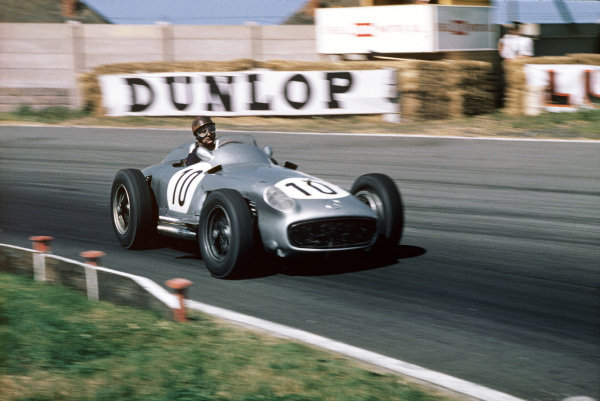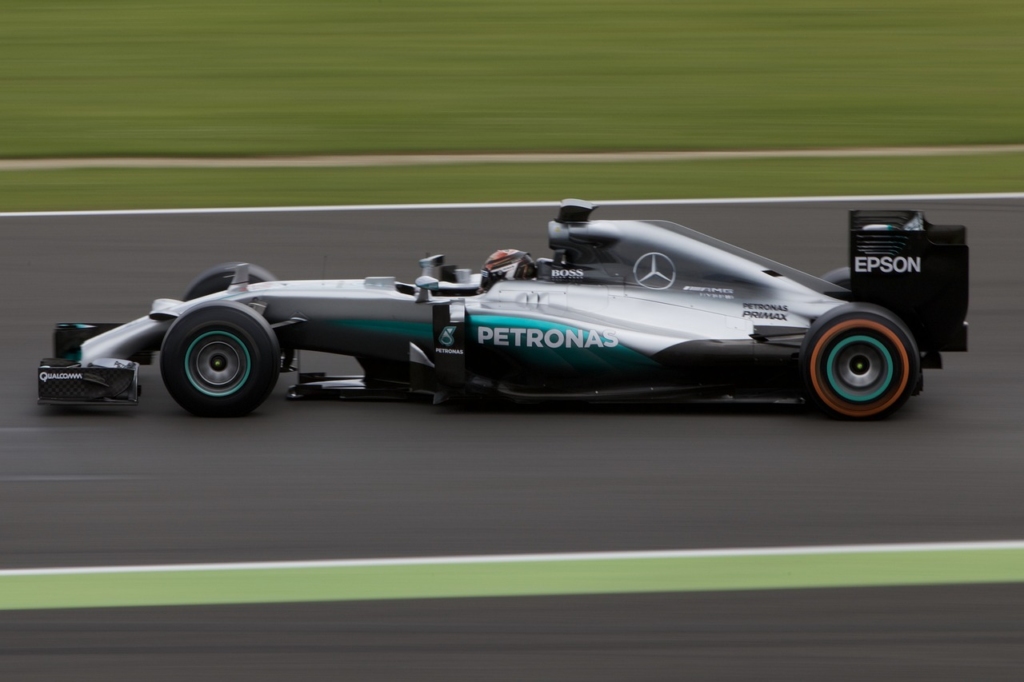Brief Overview of Mercedes in Formula 1
Mercedes-Benz has a long and storied history in Formula 1 racing, being involved in the sport on and off since the 1930s. Known for their Silver Arrows cars and dominant performances, Mercedes is one of the most successful constructors in F1 history.
They first entered as a works team in 1954 and found great success in the late 1950s before withdrawing at the end of 1955 due to the disaster during the 1955 Le Mans race, when a Mercedes crashed, and flew straight into crowd of spectators. After decades of absence, Mercedes returned to F1 in 2010 by acquiring the 2009 world champion Brawn GP team and rebranding it Mercedes GP. This marked the beginning of a new era of dominance for the Silver Arrows.
Importance of Mercedes in the History of Formula 1
As one of the most recognizable manufacturers in racing, Mercedes has left an indelible mark on Formula 1. Their periods of dominance with legendary drivers like Juan Manuel Fangio have gone down as some of the most celebrated eras in the sport.
Concepts pioneered by Mercedes like the Silver Arrows and successes at the highest level have made them one of the most storied participants in F1 history. Their fame, innovation, championships, rivalries and star drivers have woven Mercedes into the very fabric of Formula 1.
The Early Days of Mercedes in Formula 1
The Initial Entry into Formula 1
Mercedes-Benz first embarked on Grand Prix racing in the early 1930s with privateer teams, but did not enter Formula 1 in a factory capacity until 1954. By that time, they had already seen pre-WW2 success in Grand Prix racing from 1934-1939 known as the Silver Arrows.
The 1954 Mercedes F1 team came about through director Alfred Neubauer, driver Juan Manuel Fangio approaching Mercedes management about a factory effort. They decided to enter upon Fangio’s urging and in preparation for new engine regulations.
The Silver Arrows: Origin and Significance
The “Silver Arrows” nickname originated in 1934 when a Mercedes-Benz W25 weighed one kilogram over the 750 kg maximum limit. The mechanics stripped the white paint off, leaving the silver aluminum body exposed – hence the Silver Arrows were born.
The silver color became Mercedes’ racing car identity and also brought great success – Manfred von Brauchitsch won that 1934 race. This kicked off a Silver Arrows legacy of dominance, innovation and speed which also continued into the modern era of Mercedes GP racing.
Early Achievements and Challenges
Mercedes found much success when first entering F1 in 1954 and 1955. Juan Manuel Fangio won two driver’s championships, while Mercedes won back-to-back constructor’s titles. They won 9 of 12 races in the 1954 season and 10 of 11 in 1955 running away with both championships.
Despite the dominance, Mercedes withdrew from Formula 1 at the end of 1955 following a terrible crash at Le Mans that killed 83 spectators. The Mercedes board decided to end participation in motorsports, not returning until entering F1 in 2010 after a long hiatus.
The Dominance in the 50s
Key Players and Influential Figures
No figure was more key and influential to Mercedes’ 1950s F1 dominance than five-time world champion driver Juan Manuel Fangio. His skill and experience guided car development to optimize performance. He could drive around problems other drivers could not manage.
Behind the scenes, Alfred Neubauer brought immense technical knowledge and racing experience to lead the fledgling 1954 Mercedes F1 team. Engine designer Hans Scherenberg produced the powerful straight-8 engines that dominated the competition in the W196 car.
Major Races and Victories
The 1955 Italian Grand Prix featured Mercedes finishing 1-2-3-4 with Fangio taking the checkered flag ahead of Karl Kling, Piero Taruffi, and Stirling Moss. It was one of Fangio’s greatest victories as he fell behind Taruffi due to a steering issue, before charging back for the unlikely win.
At the 1954 Swiss Grand Prix, Fangio battled neck and neck with Mike Hawthorn’s Ferrari before a late pass sealed the win. Mercedes also achieved a 1-2 finish at Reims in 1954, won from pole in Britain, and set the fastest lap at nearly every race.

Impact on the Sport and Legacy
Mercedes’ 1950s success showed the superiority of German automotive engineering prowess on the world stage. It also proved the strength of Mercedes-Benz’s financial backing compared to other independent race teams. The Mercedes Silver Arrows became synonymous with speed and dominance in Grand Prix racing during that era.
Beyond the championships, Mercedes’ F1 efforts developed innovations like desmodromic valves, fuel injection, and 8-speed transmission that were eventually adopted widely on road cars. Their success raised the profile and prestige of Formula 1 substantially as well.
Challenges and Changes in Formula 1
In the late 1950s, Formula 1 began undergoing major changes that presented challenges for all teams. The governed body introduced new regulations including limiting displacement to 2.5 liters and mandatory use of Aviation gasoline rather than alcohol fuels.
These changes were intended to reduce speeds and increase safety after several fatalities. Many teams struggled to adapt, especially with reduced revenues from declining race attendance. Mercedes faced additional fallout from the 1955 Le Mans disaster which caused their initial withdrawal.
Mercedes’ Response and Adaptation
Mercedes declined to meet challenges of the new F1 regulations after withdrawing in 1955. They turned focus to sports car racing for next 30 years rather than adapting to rule changes. Several attempts were made to return to F1 between the 1960s-1980s, but none materialized despite repeated interest.
It wasn’t until 1993 when Mercedes re-entered F1 as an engine supplier to Sauber for the following season. This kicked off an era of supplying engines to partner teams McLaren, BAR and later Brawn GP. Their engines proved powerful and reliable, showing Mercedes could still adapt to F1’s technical challenges.
The Hybrid Era and Mercedes’ Dominance
Introduction to the Hybrid Era
In 2014, Formula 1 ushered in a new Hybrid engine era featuring advanced 1.6 liter V6 turbo hybrid power units with sophisticated energy recovery systems (ERS). These technologically complex power units delivered a new dimension of electric boost and fuel efficiency.
The Hybrid era represented a massive change for teams, requiring huge investments in research and development to design competitive, reliable hybrid drivetrains within extremely restrictive regulations. Only a few teams with extensive resources succeeded.
Role of Mercedes in Shaping the Hybrid Era
As a global leader in automotive technology, Mercedes-Benz played a pivotal role in shaping and dominating Formula 1’s Hybrid era. They began Hybrid development in 2011 by recruiting some of the sport’s top engine designers well before rule changes took effect.
When Hybrid units debuted in 2014, Mercedes had easily the most advanced and powerful design. Their expertise with road car hybrid drivetrains enabled unmatched understanding of hybrid systems integration to maximize performance gains.
Key Achievements and Dominant Seasons
Powered by Mercedes hybrid power units, the factory Mercedes team has won 8 consecutive constructor’s world championships since 2014 while Lewis Hamilton has claimed 6 driver’s titles. This run matches Ferrari’s 1999-2004 dominance as F1’s longest ever period of dominance by a single team.
Other major achievements in the Hybrid era include winning 74% of races since 2014 with more than 100 combined victories for Mercedes power units. The 2022 season marked their 100th F1 pole position and 80th 1-2 race finish.
Introduction to Hamilton and Rosberg
Lewis Hamilton and Nico Rosberg were teammates at Mercedes AMG Petronas from 2013-2016. Hamilton joined Mercedes in 2013 after winning his first world title with McLaren in 2008. Rosberg raced for Mercedes since 2010 after debuting with Williams in 2006.
Both were considered potential world champions, but their partnership was tense from the start due to immense driving talent and a long history racing together in youth go-karting and junior series. This bred an intense rivalry once they found themselves battling for F1 titles.
The Beginnings of the Rivalry
The Hamilton-Rosberg rivalry traces back to their days racing go-karts as young teens. Though they were good friends off track, their competition on track was fierce. Hamilton typically had the upper hand on race days, fostering a burning desire in Rosberg to someday beat his childhood rival.
These fiercely competitive tendencies surfaced again when both drivers were at Mercedes fighting for wins by 2014. Tension peaked in races like Monaco 2014 when Hamilton suspected Rosberg deliberately sabotaged his qualifying lap to secure pole position.
Key Races and Moments in the Rivalry
The 2014 Bahrain Grand Prix marked a major turning point when Mercedes teammates battled wheel-to-wheel for the victory despite team orders to hold position. Rosberg emerged victorious in that fight, prompting shift from friendly competition to bitter rivalry.

Their most controversial battle happened at Spain 2016 when the teammates crashed out on the opening lap battling for the lead. A livid Hamilton accused Rosberg of deliberately ramming him off track. This heightened their animosity to new extremes.
Impact of the Rivalry on Mercedes and Formula 1
The Hamilton-Rosberg rivalry played a major role in energizing what had been Mercedes’ total dominance over Formula 1 into a far more engaging era for fans. As Mercedes conquered all competition, the teammates dueling between themselves became the sport’s most compelling battle.
For Mercedes, it enhanced their identity as a true racing juggernaut capable of managing internal feuds. Handling the Hamilton-Rosberg feud also demonstrated the organization’s strength and maturity to weather adversity.
Mercedes Championships: A Legacy of Victory
Overview of Mercedes Championships
Since returning to Formula 1 as a works team in 2010, Mercedes has utterly dominated the sport’s Hybrid engine era that began in 2014 with Lewis Hamilton and Nico Rosberg. The team has won 8 consecutive Constructor’s World Championship titles from 2014-2021.
Hamilton claimed driver’s titles in 2014 and 2015 before Rosberg interrupted his run in 2016. Hamilton then resumed his own dominance from 2017-2020, winning 6 total driver’s crowns with Mercedes
What will happen in 2024 and forward?
With Lewis Hamilton announced in Ferrari from 2025, there are huge questions about the ability to compete for the Constructors Championship in the upcoming years. The W15 seems much more competitive than the 2022 and 2023 cars, but so far in Bahrain did not show too much race pace and potential. George Russell may not be the best team leader, as he proved to be performing poorly under pressure, just like he did in Singapore in 2023. Hamilton’s seat is a hot one, and vast majority of the field, would like to be given a chance in the Mercedes, but it’s possible that it will be given to Andrea Kimi Antonelli.

